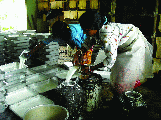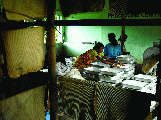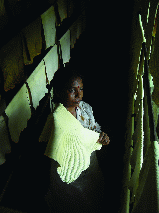Archives
Rubber empowering tribal women in Tripura
In the meantime, they squeeze out the extra water from the previous day’s slimy semisolid rubber sheets by passing it through a machine which also gives the sheets their shape. This is followed by the process of dryng these sheets.
The process is a continuous one and takes place throughout the year. But interestingly it is entirely maintained by a workforce of tribal women. None of the workers engaged in this process is a male except for the owner of the rubber estate namely Khalan Mazumder.
 Mazumder said, “Women are very dedicated to their work and so all workers here in my rubber estate are women. With the help of Rubber Board around 15 women were trained in this trade and in my estate ten of them are regularly working for the last seven to eight years. I have noticed that they are very serious with their work and so I am tension free. Thus I prefer them.”
Mazumder said, “Women are very dedicated to their work and so all workers here in my rubber estate are women. With the help of Rubber Board around 15 women were trained in this trade and in my estate ten of them are regularly working for the last seven to eight years. I have noticed that they are very serious with their work and so I am tension free. Thus I prefer them.”All these women working in the rubber estate belong to the tribal community and were either housewives or worked as daily labourers during the harvesting or sowing season as there is a shortage of male labourers.
Rubber has given these tribal ladies a permanent source of income and with that extra income they are now able to run their families more affluently.
Champa, one of the members of the group said, “We do rubber tapping and our work continues throughout
 the year. We have a five member team and start our work right from six in the morning. We are greatly benefited here as with our daily payment, we also get food from the owners of the estate.”
the year. We have a five member team and start our work right from six in the morning. We are greatly benefited here as with our daily payment, we also get food from the owners of the estate.”While another member Sita, in-charge of the processing unit said, “Earlier we used to get work only occasionally as daily labourers in cultivation fields but here seven to eight women are permanently engaged in the work.”
The rubber estate with the hard dedicated effort of these women is rapidly developing and the owner is also actively looking into it so that his workers’ problems are minimized. Recently an electric run machine has replaced the old hand run drying machine which has reduced the hardship of the workers.
“Now that we have a electric run machine in place of the hand run one, we are able to do more work and earn better to run our families in a better manner,” added Sita.
At present in Tripura 50,000 hectares of land is under rubber cultivation in which 35,000 families are involved. In terms of productivity rubber is next only to paddy, the state’s staple food.
A little more than a few years back rubber prices went down to Rs 25 per kg but now it is selling at Rs 170-180 per kg. This is again encouraging farmers to shift to rubber cultivation.
 “The price of rubber had drastically fallen and people were not interested in rubber cultivation but now rubber is the most profitable item in Tripura and so everyone here is interested in rubber production. We are lucky to have suitable climatic conditions for rubber cultivation and the present age is the golden period of rubber cultivation in Tripura,” said Mazumder.
“The price of rubber had drastically fallen and people were not interested in rubber cultivation but now rubber is the most profitable item in Tripura and so everyone here is interested in rubber production. We are lucky to have suitable climatic conditions for rubber cultivation and the present age is the golden period of rubber cultivation in Tripura,” said Mazumder.Tripura is the second highest producer of rubber in India after Kerala but the quality of rubber which is produced in Tripura is the best that can be found in the country.
The state government of Tripura had earned consolidated revenue of Rs 150 crore in the financial year 2008-2009 from taxes and duties out of rubber.
Pinaki Das

